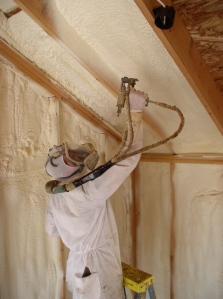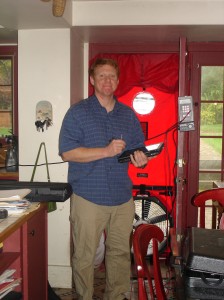Think Spring – Think Green!
May 11, 2009
 Spring is the perfect time for us to air out the house, throw open the windows and closets, and assess what we’ve got. It’s a wonderful time to start thinking about changes to your home – adding that extra bedroom or family room you’ve been dreaming of, remodeling your circa 1950’s kitchen, creating a better connection between your house and garden…Beginning the planning process in the spring is perfect for summer construction.
Spring is the perfect time for us to air out the house, throw open the windows and closets, and assess what we’ve got. It’s a wonderful time to start thinking about changes to your home – adding that extra bedroom or family room you’ve been dreaming of, remodeling your circa 1950’s kitchen, creating a better connection between your house and garden…Beginning the planning process in the spring is perfect for summer construction.
Renovation and addition projects make more sense than ever this year. Many homeowners have put aside thoughts of relocating and have decided to stay in their homes and work with what they have. Making thoughtful improvements to an existing home, so it will work better for your family and remain useful for decades, is one of the greenest steps you can take. Enormous savings in energy and material resources are found by renovating instead of building new, since building new not only includes the construction materials, but often also includes demolition or disturbing a previously undeveloped site. Savvy homeowners are learning how even small changes, such as adding cabinetry, enlarging an opening between rooms, or even painting can make a world of difference in their enjoyment of their homes.
In our projects, our evaluation and design process includes giving our clients options for additional home improvements they may not have considered to be part of their project: insulation, window and door repair, mechanical, electrical and plumbing upgrades. These not-so-glamorous changes enhance comfort and enjoyment of the home, bring substantial energy cost savings and reduce the home’s negative impact on the environment.

This year and next, we have large rebate, loan and tax incentives available from National Grid and the Federal government for weatherization improvements to existing homes. The following are summaries of what is available. See the websites for more information.
Utility Rebates and Loans:
Through the MassSAVE program, National Grid will fund 75% of the cost (up to $2,000) of insulation, air sealing, windows and caulking/weather-stripping for work completed through July 31st of this year.
Through their Appliance Mangement program, National Grid offers rebates for equipment insulation, energy-efficient water heaters, refrigerators, furnaces and boilers, programmable thermostats, lighting and duct/air sealing. These rebates vary depending on the equipment purchased.
Through MassSAVE’s statewide HEAT loan program, 0%(!!!) loans for energy-efficiency technologies up to $15,000 with terms up to 7 years are available. The technologies covered include water heaters, furnaces, boilers, heat pumps, programmable thermostats, duct/air sealing, building insulation and windows.
Federal Tax Credits
A 30% tax credit (up to $1,500) is available for water heaters, furnaces, boilers, heat pumps, air conditioners, building insulation, doors, windows and biomass stoves. This credit is available for items placed in service in 2009 and 2010. 
What do these incentives mean for the average homeowner?
A client of ours decided to include the installation of attic soy-based foam insulation to the other construction items underway in his home. The insulator helped with the rebate paperwork. With the 75% rebate from National Grid, coupled with the 30% tax credit from the Federal government (Yes, it adds up to 105%!), they will get money back for adding insulation! Of course, the increased comfort and energy cost reduction will benefit them for years to come.
 Energy Audit
Energy Audit
Each home is different. Having an energy audit done by a non-affiliated auditor is the best way to prioritize which projects will make sense for your home. Although the costs vary depending on the size of the house, you can expect to pay around $1200 for their full services. The auditors that we work with use blower-door tests to test the air-tightness of the home and an infrared camera test to see where leaks and gaps are in the walls and roof. They use this data with a year of the homeowner’s energy bills to create a written report that includes recommendations for energy efficiency improvements and associated expected cost-savings. They will also perform a follow-up test after the work is complete to verify the system upgrades are working as expected. With the auditor’s information and knowing the incentives available, you are equipped to make the right decision for improvements to your home.
With these incentives in place, this year is the time to take on these projects. It is important to start with an energy audit, to understand the requirements of the incentives and to have a qualifed and informed installation contractor. These contractors have a good handle on the incentives available and usually will help you with the paperwork.
If you need any assistance with your Spring planning or connecting you with an auditor, contractor or installers, let me know. As always, feel free to contact me with any other questions.
Happy Spring!!
For more information see: DSIRE USA and National Grid